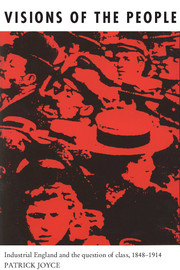Book contents
- Frontmatter
- Contents
- List of plates
- Acknowledgements
- 1 Introduction: beyond class?
- PART I POWER AND THE PEOPLE: POLITICS AND THE SOCIAL ORDER
- PART II MORALISING THE MARKET: WORK AND THE SOCIAL ORDER
- PART III CUSTOM, HISTORY, LANGUAGE: POPULAR CULTURE AND THE SOCIAL ORDER
- PART IV KINGDOMS OF THE MIND: THE IMAGINARY CONSTITUTION OF THE SOCIAL ORDER
- 9 Investigating popular art
- 10 The broadside ballad
- 11 The voice of the people? The character and development of dialect literature
- 12 Dialect and the making of social identity
- 13 Stages of class: popular theatre and the geography of belonging
- 14 Summary and conclusion: the making of the English working class before 1914?
- Appendices
- Bibliographical note
- Notes
- Index
14 - Summary and conclusion: the making of the English working class before 1914?
Published online by Cambridge University Press: 05 March 2012
- Frontmatter
- Contents
- List of plates
- Acknowledgements
- 1 Introduction: beyond class?
- PART I POWER AND THE PEOPLE: POLITICS AND THE SOCIAL ORDER
- PART II MORALISING THE MARKET: WORK AND THE SOCIAL ORDER
- PART III CUSTOM, HISTORY, LANGUAGE: POPULAR CULTURE AND THE SOCIAL ORDER
- PART IV KINGDOMS OF THE MIND: THE IMAGINARY CONSTITUTION OF THE SOCIAL ORDER
- 9 Investigating popular art
- 10 The broadside ballad
- 11 The voice of the people? The character and development of dialect literature
- 12 Dialect and the making of social identity
- 13 Stages of class: popular theatre and the geography of belonging
- 14 Summary and conclusion: the making of the English working class before 1914?
- Appendices
- Bibliographical note
- Notes
- Index
Summary
The icons of popular art suggest the force and longevity of populist notions over this period. They also indicate that rather than a single populism, it is a variety or ‘family’ of populisms that should be considered, a variety in which the capacity for change and adaptation was marked. In the northern, industrial districts there was, however, a decided continuity amidst this variety and change. This was evident in a radical populism conceiving of the true England as the industrial north in struggle with Privilege. The conception of a ‘family’ of populisms was invoked in the first part of this book, on politics. There the roots of social identity were in important measure seen to lie in ideas and associations taken from politics, in particular the populist traditions of popular radicalism and the many tranformations these went through up to 1914. The controlling narrative of popular politics appears to have concerned a righteous and dispossessed ‘people’ rather than a ‘working class’. The political sphere paralleled the sphere of art here: the idea of the true, unadorned England of the north was a varient of the broader mythology of the true political nation of the excluded English.
The excluded English could be seen as the labouring English, and in this sense ‘class’ appropriations occurred, even though this was in practice rather limited.
- Type
- Chapter
- Information
- Visions of the PeopleIndustrial England and the Question of Class, c.1848–1914, pp. 329 - 342Publisher: Cambridge University PressPrint publication year: 1991



